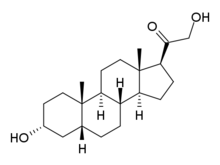테트라히드로데옥시코르티코스테론
Tetrahydrodeoxycorticosterone | |
| 임상자료 | |
|---|---|
| 기타 이름 | TDOC |
| 식별자 | |
| |
| CAS 번호 |
|
| 펍켐 CID | |
| 유니 | |
| ECHA InfoCard | 100.008.457 |
| 화학 및 물리적 데이터 | |
| 공식 | C21H34O3 |
| 어금질량 | 334.500 g·mits−1 |
| 3D 모델(JSmol) | |
| |
| (iii) | |
테트라하이드록시코르티코스테론(THDOC, 약칭 3α,21-디하이드록시-5α-프리그난-20-1)은 내생 신경스테로이드라고도 한다.[1] 부신호르몬인 디옥시코르티코스테론으로부터 5α-감소효소 타입 I과 3α-히드록시스테로이드 탈수소효소라는 두 효소의 작용에 의해 합성된다.[2] THDOC는 GABAA 수용체의 강력한 양성 항불안제 변조기로 진정제, 항불안제, 항경련제 효과가 있다.[3][4][5] 특히 임신과 생리 중 이 스테로이드의 정상 수치의 변화는 스트레스, 불안, 우울증뿐만 아니라 어떤 종류의 간질(카멘탈 간질)과 월경 전 증후군에 관련될 수 있다.[6][7][8][9][10][11]
화학
참고 항목
- 알롭페르탄올론
- 디히드로데옥시코르티코스테론(DHDOC)
- 테트라하이드로코르티코스테론(THB)
참조
- ^ Hosie AM, Wilkins ME, da Silva HM, Smart TG (November 2006). "Endogenous neurosteroids regulate GABAA receptors through two discrete transmembrane sites". Nature. 444 (7118): 486–9. Bibcode:2006Natur.444..486H. doi:10.1038/nature05324. PMID 17108970. S2CID 4382394.
- ^ Agís-Balboa RC, Pinna G, Zhubi A, Maloku E, Veldic M, Costa E, Guidotti A (September 2006). "Characterization of brain neurons that express enzymes mediating neurosteroid biosynthesis". Proceedings of the National Academy of Sciences of the United States of America. 103 (39): 14602–7. Bibcode:2006PNAS..10314602A. doi:10.1073/pnas.0606544103. PMC 1600006. PMID 16984997.
- ^ Kokate TG, Svensson BE, Rogawski MA (September 1994). "Anticonvulsant activity of neurosteroids: correlation with gamma-aminobutyric acid-evoked chloride current potentiation". The Journal of Pharmacology and Experimental Therapeutics. 270 (3): 1223–9. PMID 7932175.
- ^ Reddy DS, Rogawski MA (May 2002). "Stress-induced deoxycorticosterone-derived neurosteroids modulate GABA(A) receptor function and seizure susceptibility". The Journal of Neuroscience. 22 (9): 3795–805. doi:10.1523/JNEUROSCI.22-09-03795.2002. PMC 6758375. PMID 11978855.
- ^ Reddy DS (2003). "Pharmacology of endogenous neuroactive steroids". Critical Reviews in Neurobiology. 15 (3–4): 197–234. doi:10.1615/critrevneurobiol.v15.i34.20. PMID 15248811.
- ^ Tuveri A, Paoletti AM, Orrù M, Melis GB, Marotto MF, Zedda P, et al. (July 2008). "Reduced serum level of THDOC, an anticonvulsant steroid, in women with perimenstrual catamenial epilepsy". Epilepsia. 49 (7): 1221–9. doi:10.1111/j.1528-1167.2008.01555.x. PMID 18325018. S2CID 23596739.
- ^ Reddy DS (March 2003). "Is there a physiological role for the neurosteroid THDOC in stress-sensitive conditions?". Trends in Pharmacological Sciences. 24 (3): 103–6. doi:10.1016/S0165-6147(03)00023-3. PMID 12628349.
- ^ Reddy DS (2006). "Physiological role of adrenal deoxycorticosterone-derived neuroactive steroids in stress-sensitive conditions". Neuroscience. 138 (3): 911–20. doi:10.1016/j.neuroscience.2005.10.016. PMID 16325348. S2CID 23576732.
- ^ Eser D, Romeo E, Baghai TC, di Michele F, Schüle C, Pasini A, et al. (2006). "Neuroactive steroids as modulators of depression and anxiety". Neuroscience. 138 (3): 1041–8. doi:10.1016/j.neuroscience.2005.07.007. PMID 16310959. S2CID 12033307.
- ^ Eser D, Schüle C, Baghai TC, Romeo E, Rupprecht R (2006). "Neuroactive steroids in depression and anxiety disorders: clinical studies" (PDF). Neuroendocrinology. 84 (4): 244–54. doi:10.1159/000097879. PMID 17159334. S2CID 15711990.
- ^ Maguire J, Mody I (February 2007). "Neurosteroid synthesis-mediated regulation of GABA(A) receptors: relevance to the ovarian cycle and stress". The Journal of Neuroscience. 27 (9): 2155–62. doi:10.1523/JNEUROSCI.4945-06.2007. PMC 6673487. PMID 17329412.


